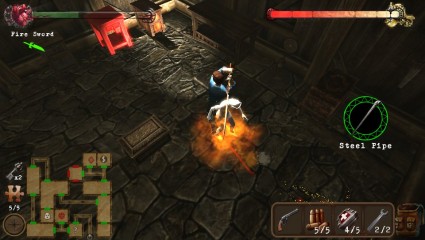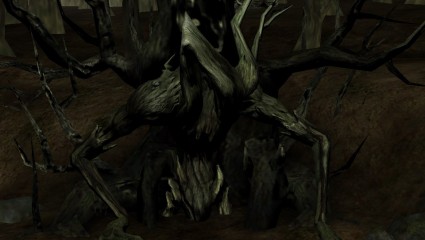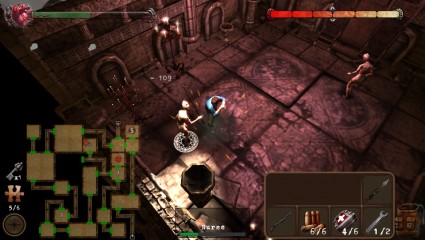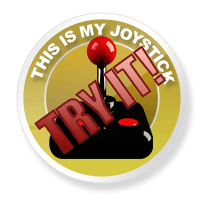Reviews
Silent Hill: Book of Memories
November 5, 2012, Author: Andy Corrigan
Book of Memories just hasn’t had the best start in life. Unfairly derided by Silent Hill fans (who in most cases hadn’t even played the game) for daring to be a spin-off in another genre, WayForward’s Dungeon Crawler has got a lot to do to win over its nay-saying critics.
Regardless, I was one of those more intrigued by the concept than turned off by it. I enjoy Silent Hill games (though I’m not a rabid fan), and I’ve recently found a new interest in Dungeon Crawlers, thus I was completely open-minded about letting it win me over.
That said, when I gave our Demo Impressions a few weeks back, I was left with a few concerns. Would it change the formula enough to remain interesting? Would it offer the right incentives of powers and abilities to keep gamers hooked?
Unfortunately, most of my concerns were realised; it doesn’t quite do enough, yet its issues don’t derail it completely…
By the book!
At first glance, Book of Memories certainly has an interesting setup, asking you one simple question: what if you could rewrite every memory you ever had?
Your created character is about to find out, as they receive a mysterious book for their birthday. Upon reading it, they’re initially freaked out to discover that everything they’ve ever lived, every memory they’ve ever had is written in the pages. The thought strikes them: what if they rewrite it?
They take a pen to the withered old pages, changing the passages to dictate that they got a promotion that they were previously passed over for. Happy with their work, they drift off to a heavy sleep, where they are transported to a locale familiar to Silent Hill fans…
After battling through the first dungeon, they awake from their slumber in the real world, only to discover that the much coveted promotion is now theirs. Ecstatic, they set about changing other less desirable aspects of their life…
As awesome as that premise sounds, the story is water-thin and not really explored as it could have been. A lot of the time, you’re wandering around not even remotely sure how what you’re doing ties in with what the character is trying to change, and in this respect, the gameplay and story are at opposite sides of the room, refusing to make eye contact.
It’s a massive shame because that premise could have led to some very interesting and poignant moments in gameplay, and as such it feels like a bit of a missed opportunity.

Looks like Diablo, doesn't it?
Going against the grind…
As a Dungeon Crawler, Book of Memories has you exploring Silent Hill themed levels from an isometric view, fighting off monsters and trying to reach the end of the level. Your objective never actually changes: find and activate all the challenge orbs, beat the resulting enemies to collect puzzle pieces, and then head to the exit to solve the puzzle and leave. Even the game’s general structure repeats, giving you three levels in each environment before sticking you in a boss fight.
There are some optional side-missions, but not in the traditional sense. There’s no quest log; you’re simply given a mission by the demon Valtiel at the level entrance and it’s up to you whether you complete it before you finish or not. By completing these missions, though, you’re rewarded for your efforts and offered new, powerful weapons or artifacts.
Looting doesn’t really happen as you’d expect either. Unlike most games of its ilk, you don’t build up an inventory of loot and stop to micromanage, kitting out your character with the best equipment. You won’t, as a quick example, find a new knife and check its stats against the one you currently own, simply because it’s not really possible to do so. In the beginning you’ll only be able to hold one weapon in either hand (or one huge weapon in both), and while you can eventually upgrade your backpack at a shop to store more, you’ll never build up an arsenal as you would in Diablo, Borderlands or Torchlight. Instead you’ll be hot-swapping your weapons on the fly.
I found that this system took a lot of the joy out of finding new gear. In fact, if it wasn’t for the fact that weapons degrade pretty quickly, there’d be no need to change all that often. If you have wrenches, you can fix your weapons quickly at any time, with just a quick tap of the on-screen button, but they’re a scarce commodity throughout. So, there will be times you’ll either need to give up that sweet-ass fire sword that’s about to break or spend the money to buy a repair kit at the shop.
The combat system is pretty simplistic, repetitive button mashing for most part, but it’s at least someway fun. You can map two smaller weapons, say a knife in your left hand and a wooden plank in your right, and wail on enemies with each weapon individually (Square button for left hand, Triangle for right). Instead you could have a cleaver in one hand and a handgun in the other, or two handguns if you wanted. You could decide to carry one large weapon in both hands, such as a shotgun or a steel pipe; it’s pretty flexible all round.
Guns are easy to use too, locking into enemies with the Left Bumper and firing with whichever attack button is appropriate. Once you run out of ammo, you can reload quickly with the on-screen button, if you have bullets in your backpack. If not you’ll start using the gun as a mêlée weapon.
For the most part, you’ll have access to basic weapons in knives, handguns, planks of wood, and these never seem to change; however, later in the game you’ll get access to some of the sweeter additions, such as Assault Rifles and Flame Throwers, which really help in those tougher levels.
The enemies are all ripped from the series, so you’ll see nuns, two-headed dogs, spewing freaks in straightjackets, Butchers, and even an appearance of Pyramid Head. They all have their own little quirks, and best way to approach, but for the most part it’s just wail on them or shoot them repeatedly. The boss fights are the most interesting aspect when it comes to battles, with some requiring brains over brawn to bring them down.
Levelling your character is a very understated affair, and it’s clunky too. In fact, everything you do in the menus is pretty clunky. With every level you get two points to spend across eight different attributes and, as you find them and unlock the slots, you can assign Artifacts to further boost stats. It’s light on RPG elements in this respect, though there is a slight smidgen of depth in the way that your character can get more proficient with a weapon the more they use it.
There are powers and abilities to use too, and these are managed by the Karma meter. There are three types of enemies: Blood, Light and Steel. By killing and collecting the remains of Light enemies, you’ll unlock destructive abilities, and by killing the Blood creatures and collecting their remains, you’ll access defensive abilities. To operate these when the Karma is aligned in the balance you desire, you simply tap the gauge in the top-right of the screen and choose your ability from the subsequent menu; it’s a little tricky in the middle of combat, though. Some of the abilities are especially fiddly, such as the one that drains power from your chosen enemy, requiring you to highlight the enemy using a cursor control from the back touchpad.
There are a few different types of room that you’ll encounter, aside from the Challenge Orb rooms mentioned above and standard rooms. There are roulette rooms that will grant you one-use powers for that level, shops, and Artifact rooms. Forsaken Rooms aren’t available in multiplayer, though their inclusion serves very little purpose. These are haunted rooms in which great tragedy supposedly happened, and you interact with their eerie inhabitants in different ways. They’re interesting, if totally pointless.
The Altar rooms serve as save points, and this is truly one of the most frustrating things about the entire game. These save rooms could be anywhere on a map, even near the end of the level. So if you’ve spent ten or fifteen minutes battling through enemies without finding it, and then die, you’ll instantly lose all that progress. I can tell you that is fucking frustrating.
The rooms themselves contain their own dangers that can help make dying in that way a reality too, aside from the enemies. Some rooms feature hidden panels that trigger different effects. One might slow down all that are caught in its diameter, some might quickly drain you of health depending on your Karma alignment, or some might pierce you with spikes. That said, there are some that provide health and buffs, if you’re lucky.
The game’s main problem is that it’s really just one massive, uninvolving grind. The formula and pace never changes, and it doesn’t bless you with any truly sweet abilities that make the game abundantly fun. Yet there is still an addictive quality here that I can’t quite put my finger on. Without being terribly engaging, it still manages to encourage you to keep trying, even in times of frustration.

This guy's got wood...
Polygon head…
One thing I will say about Book of Memories is that it looks so much better than the prior demo managed to convey. Textures and edges are shaper, and overall the game looks decent and runs very smoothly. Don’t get me wrong; it’s far from the best-looking game on the system, but it’s certainly not the worst.
The environments are the real star of the show, truly capturing the Silent Hill vibe on every conceivable level, feeling dank, dingy and claustrophobic. Despite the game being void of the series’ usual scares, it manages to provide a tense atmosphere regardless.
Silent Hill?
The music is also ripped right from the other Silent Hill games, which is another key factor in the atmosphere just mentioned. The industrial drone and deep stabs still manage to chill, even in this spin-off where scares aren’t the game’s main objective.
The voice acting is fine without really impressing. I mean, the game isn’t drama-filled or story-heavy enough to warrant any outstanding performances, so I suspect that the vocal cast have done the best with what they had to work with.
You’re not alone…
Silent Hill’s multiplayer is the place where a lot of the game’s frustrations fade away, especially with that horrendous save system. Jump in with a friend or stranger and you can tackle any zone the host likes cooperatively. If you die, you’re just put back to the beginning of the level, with all your progress intact.
Still, despite being smooth as hell with solid net code, it has its issues. There is no drop in, drop out system in play; it’s all lobby-based. You can’t be playing on your own, spot your mate log into PSN and fire him an invite. Instead you have to go the multiplayer menu and create or join a game. For this type of game, it’s pretty annoying.
The good news is that you still use and progress the same character. So you can jump into someone’s lobby and play a level that you’ve not reached yet, level up, earn stats, grab weapons that you wouldn’t otherwise have access to, and take it all back to your solo game later. For example, I managed to get a flamethrower long before I should have, and this was a great help in the zone I was previously stuck in.
Aside from that, the game is pretty much identical to the solo campaign, only without the save frustration. Seriously, if you can play it this way, I’d highly recommend it.

Say goodnight, Nurse. Heh, with a cool, dry wit like that, I could be an action hero...
Memorable?
Overall, Book of Memories is not a terrible game, but it’s not a great one either. Despite its flaws and frustrations, and even without the dangling carrot of a compelling loot system, it managed to keep something of a little hold on me. Why exactly that is, I can’t quite put my finger on, but there’s just something there that compels you onwards. I reckon, as annoyed as I got with it at times, I’d still be playing it now if it wasn’t for the need to review other games, although not always happily.
Its flaws are undeniable and glaring. It’ll bore you often, frustrate you more, and at times make you want to throw your Vita across the room in anger. There are some bizarre design choices that undermine its successes, leaving you wondering what WayForward were thinking, but the makings of a quality game are clearly here.
With a little more thought and attention, you could have been dealing a truly great dungeon crawl. Instead, it’s one that’s merely okay…
Platforms: PS Vita | Tagged Diablo, dungeon, Dungeon Crawler, Konami, loot, Nurses, Pyramid Head, Silent Hill, Silent Hill: Book of Memories, The Butcher



